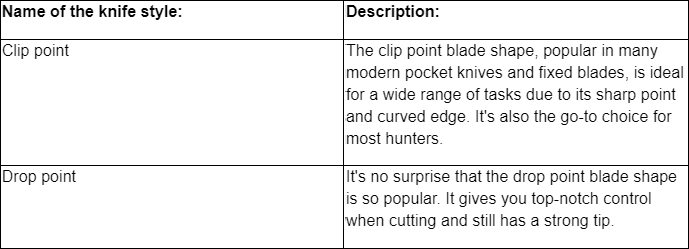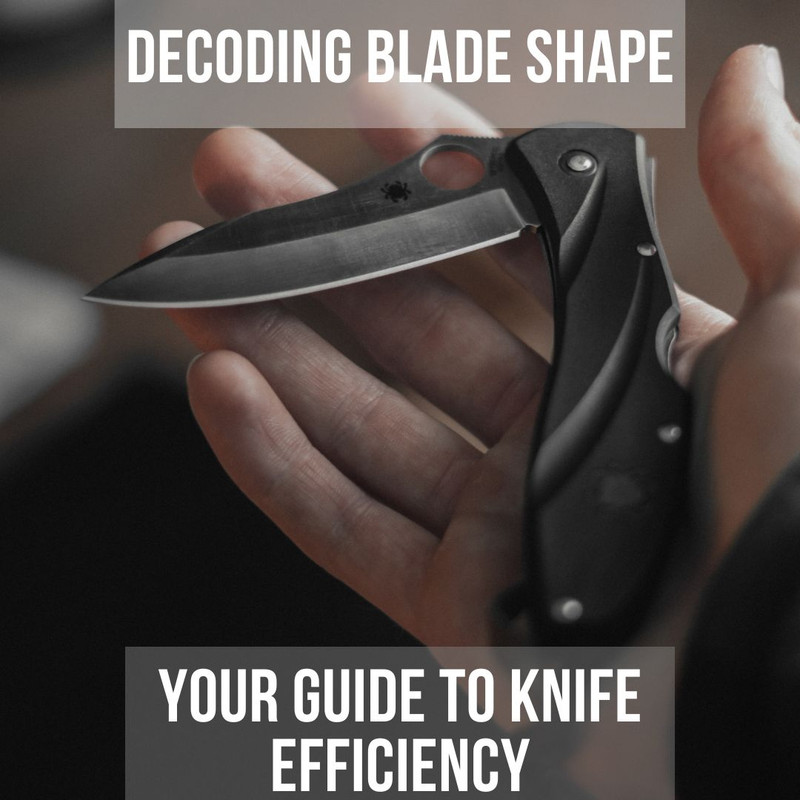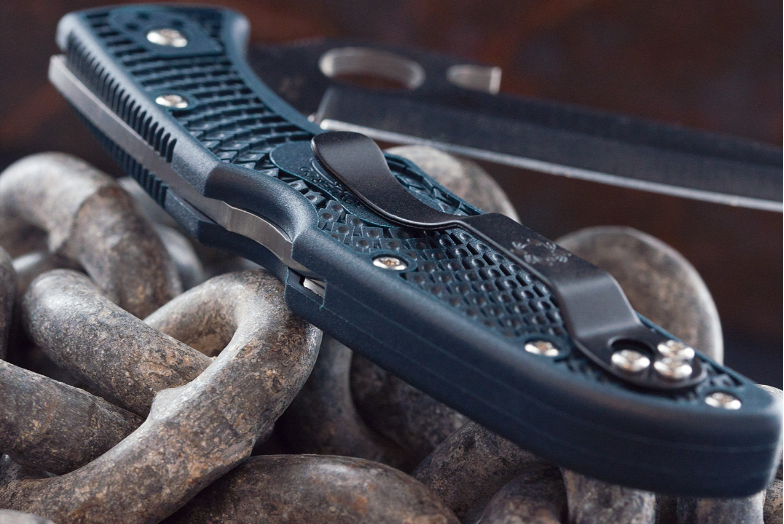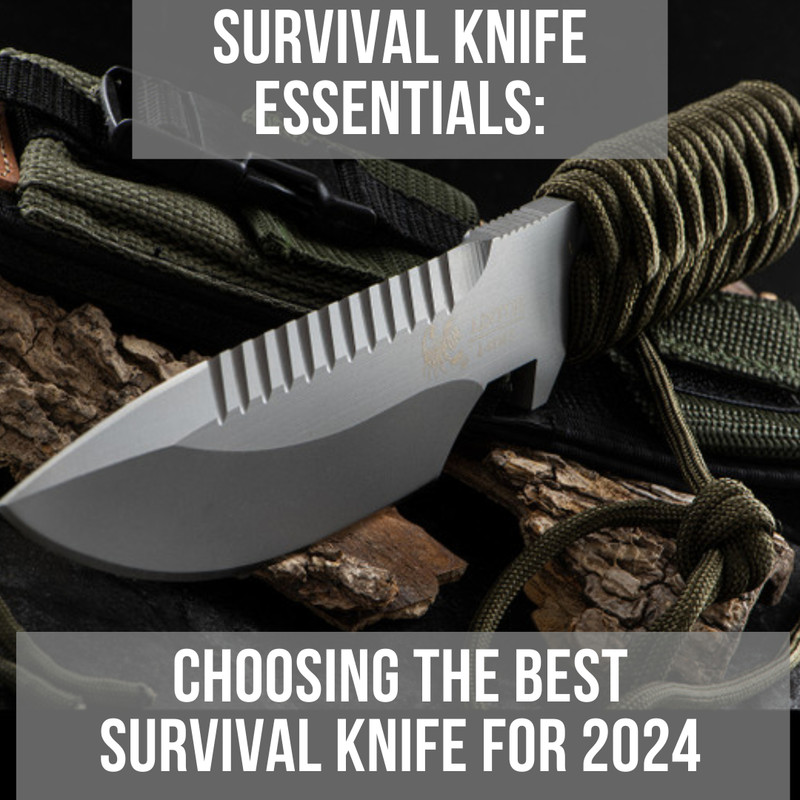Decoding Blade Shape: Your Guide to Knife Efficiency
Posted by HH on 11th Oct 2023
Have you ever held in your hand a knife with a particular blade shape and wondered, "What makes this design so special?" It's more than just an aesthetic appeal; it's about function meeting form. Picture the gleaming edge of a tanto blade or the curvature of a sheepsfoot knife - each with its own unique purpose.
I remember my first encounter with an intriguing clip point blade. The pointed yet curved design fascinated me, not knowing then that it was built for precision cutting tasks.
This isn't merely about blade shape but how blades define our interaction with objects around us - from opening packages to field dressing game. And today we're diving into this captivating world where every curve matters, and every point tells a story.
Got your interest piqued? Let's dive deeper! We're about to explore everything from familiar drop points to the less conventional recurve blades.
Table Of Contents
- Blade shape basics and importance
- Understanding blade geometry
- Cutting edge dynamics
- Symmetry matters too
- Common blade shapes and their uses
- Technical aspects of blade shape
- Role of cutting edge in knife performance
- Influence of blade style on performance
- Specialised blade shapes and their uses
- Bowie knife: the historic heavy hitter
- Dagger blade: symmetry meets functionality
- Hawksbill blade: niche masterpiece
- Exploring the drop point blade shape
- A closer look at drop point features
- The role of blade shape in cutting efficiency
- Impact of blade shape on durability
- Cutting power: curves versus straight edges
- Avoiding unwanted damage
- Popular blade shapes for different tasks
- Choosing a blade shape for EDC tasks
- Tactical blades: tanto point vs spear point
- Hunting knives: drop point vs gut hook
- Impact of blade shape on handle material selection
- The dance between durability and grip
- Tactical knives: balancing functionality with stealth
- Folding versus fixed blade handles
- Hunting blades need balance and comfort
- Blade style dictates handle material
- Exploring unconventional blade shapes
- The leaf shape blade: strength meets slicing power
- Recurve blades: pulling you into its charm
- Getting acquainted with the unusual
Blade shape basics and importance
The blade shape is the beating heart of any knife. It determines its character, its strengths, weaknesses and ultimately how it performs in your hand. The right choice can mean the difference between a useful tool and an expensive paperweight.
Understanding blade geometry
A knife's geometry isn't just about aesthetics or style - it's pure science at work. Every curve, angle and edge contributes to how efficiently that blade will perform under various conditions.
In simple terms, blade geometry refers to the design of a knife’s cutting surface including aspects like thickness along with spine curvature. Our EDC buying guide delves into this topic more deeply, for those interested.
Cutting edge dynamics
Different tasks demand different 'cutting dynamics'. A straight cutting edge excels at chopping motions whereas a curved belly improves slicing capability - knowing which suits your needs best is crucial when choosing a blade shape.
Symmetry matters too
Symmetrical blades are great all-rounders as they offer good control over both slicing and piercing tasks, but asymmetrical designs may provide advantages in specific scenarios such as skinning game or carving woodwork details.
Common blade shapes and their uses

Technical aspects of blade shape
The shape of a blade is not just about aesthetics. It's an amalgamation of technical aspects that can drastically affect a knife's performance.
Role of cutting edge in knife performance
A knife’s cutting edge plays a pivotal role in its overall functionality. The design and geometry dictate how well the blade performs certain tasks. For instance, straight edges offer precise control for push cuts, making them ideal for carving or slicing tasks.
Conversely, curved blades are perfect when you need to slice with a rocking motion. This attribute makes them great companions for hunters who perform field dressing, as they make long sweeping slices easier.
Read our Essential Guide to Top-Rated Hunting Knives in the UK
Symmetrical blades bring balance into play, which is particularly important if precision matters in your task list more than raw power. So depending on what job you're tackling - whether it be whittling wood or preparing dinner - the cutting edge design might sway your choice one way or the other.
Influence of blade style on performance
Different styles have different strengths and weaknesses when put under scrutiny. Their designs serve specific purposes better than others due to inherent features and characteristics shaped by centuries-old traditions and modern innovations alike. The influence each style exerts over its user experience cannot be overstated: they modify the balance point (or centre-of-mass), affect sharpness retention rates, and even define what type(s) of cut(s) work best with them.
You'd want clip point blades for piercing because these come tapered to such a degree that minimises drag – thus facilitating deeper penetration without exerting too much force. In contrast, spear point blades shine in tasks that require balance above all else due to their symmetrical blade shape and sharp point. For those seeking a multipurpose tool then a spear point knife of superior quality could be the ideal choice.
Each shape performs differently, excelling or falling short in specific tasks. It's all about finding the right fit.
Key takeaway:
The shape of a blade isn't just about looks - it plays a major role in how well the knife performs. If you need precision (like when carving) then straight edges are your best bet. On the other hand, curved blades make rocking motion slices easier for hunting or cooking tasks. Blade style matters too. Clip points excel at piercing and spear point knives bring balance and versatility to the table. So remember, picking out the right blade really comes down to what you specifically need it for.
Specialised blade shapes and their uses
The world of knives is not limited to the familiar shapes you see in your kitchen. Specialised blade shapes like Bowie, Dagger and Hawksbill blades offer unique functionalities for various tasks.
Bowie knife: the historic heavy hitter
A Bowie knife's shape has a strong historical significance. This blade, which features a large belly ideal for slicing and a sharp point, was popularised by James Bowie in the 19th century.
This type of blade design, while perfect for survival situations or hunting trips, may not be suited for everyday carry due to its size and weight. But if strength is what you're after then there's nothing quite like wielding a piece of history.
Dagger blade: symmetry meets functionality
When precision meets functionality we get the dagger blade, which have found their use in a multitude of civilian applications.
The dual cutting edges give them excellent piercing capabilities which make them particularly useful when precision matters most – such as field dressing game, or even certain EDC tasks where having two sharp sides can prove handy.
Hawksbill blade: niche masterpiece
Moving onto more specialised territory, we encounter the hawksbill knife shape. With its inwardly curved edge (much like that of a hawk’s bill), this type excels at specific functions such as cutting cords or ropes thanks to how materials are drawn into its concave surface rather than slipping off from convex designs.
While it's not an all-rounder, in the right hands this tool becomes indispensable. Take care when handling this knife, as its sharp point and special shape can cause major injury if not managed properly.
Every blade comes with its own pros and cons. That's why understanding your main use for the knife is crucial - it'll guide you to a smart, informed choice. Whether it's Bowie's historic power, Dagger’s pinpoint accuracy, or another knife’s specific strengths.
Key takeaway:
Knives are more than just kitchen tools. Unique types like the Bowie, Dagger and Hawksbill each bring their own strengths to different tasks. The robust Bowie is ideal for slicing; Daggers blend pinpoint accuracy with practicality (perfect when precision matters); while a Hawksbill blade's curved edge shines in particular jobs such as cutting cords or ropes.
Exploring the drop point blade shape
The drop point blade shape is considered by many as the best blade design for a wide range of tasks. The popularity of the drop point blade shape is attributed to its combination of robustness, adaptability and precision.
This common blade shape is found on various types of knives such as hunting knives, pocket knives and even some tactical knives. Its large belly makes it an excellent choice for slicing while maintaining enough point sharpness to handle finer tasks effectively.
A closer look at drop point features
The drop point features a straight cutting edge that extends from the handle up to around three-quarters or more towards the tip. From there, we see where this knife gets its name. The back (or unsharpened) edge ‘drops’ down toward the cutting edge creating what's known as 'the belly' before meeting at a relatively broad tip.
Contrary to popular belief, not all drop points have rounded curves leading towards their tips – they can also be angled depending on their intended use or user preference. These are often referred to as modified drop points because they borrow elements from other styles like clip points but retain their characteristic dropping spine.
Key takeaway:
The drop point blade shape is lauded for its unique mix of strength, versatility and control. With features like a large belly for efficient slicing and a sharp enough tip to manage finer tasks, it's ideal for diverse applications from hunting to everyday carry (EDC). Its robust tip provides added strength during puncturing tasks while the broad straight cutting edge offers easy control over cuts.
The role of blade shape in cutting efficiency
When it comes to knives, the blade shape is a major factor that influences cutting efficiency. Different shapes are designed for specific tasks and have their unique strengths.
Impact of blade shape on durability
A knife's durability isn't just about its material or construction; the blade shape plays an equally crucial role. For instance, blades with a thick spine like tanto point and cleaver blades tend to be more robust than others.
In contrast, designs such as spear points and clip points offer balanced strength due to their symmetrical structure. These forms maintain a sturdy spine while providing enough sharpness at the tip for detailed work. Spear point blades - popular among throwing knives enthusiasts because they're balanced and durable - illustrate this principle perfectly.
Straight edge styles like the Wharncliffe blade also prove resilient over time. The straight cutting edge reduces wear by evenly distributing pressure across the length of the blade during use.
Cutting power: curves versus straight edges
Different tasks require different levels of cutting power – some need precision; others demand raw force. Blades with curved bellies like drop point or trailing point often deliver greater cutting power since they engage more edge length when slicing through materials compared to straight-edge types. Drop point blades are versatile examples that provide ample belly for effective slicing while maintaining sufficient control thanks to their gentle curve design.
Tanto blades, originally designed for piercing armour, are another excellent example where geometry significantly impacts performance. With their angular design, tanto blades are extremely strong and perfect for heavy-duty tasks.
Avoiding unwanted damage
Another aspect of cutting efficiency is the ability to avoid puncturing or damaging materials unintentionally. Sheepsfoot blades, gut hook blades, and Wharncliffe style designs have blunter points designed specifically to prevent accidental piercing. Sheepsfoot knives excel in tasks such as field dressing game where it's crucial not to pierce organs while making cuts.
A gut hook blade offers a specialised form that allows hunters to open and dress game without puncturing internal organs.
Key takeaway:
Blade shape greatly impacts a knife's cutting efficiency and durability. For instance, thick-spined blades like tanto points offer robustness while spear point designs balance strength with sharp precision. Straight-edge styles distribute pressure evenly, prolonging their lifespan. Meanwhile, curved bellies on drop point or trailing point knives deliver powerful slicing action and are versatile for various tasks.
Popular blade shapes for different tasks
Whether you're peeling an apple, cutting rope or defending yourself, the blade shape plays a critical role in its performance.
Choosing a blade shape for EDC tasks
Your everyday carry (EDC) knife should be versatile and capable of handling common tasks. The drop point blade, with its curved belly and strong tip, makes it an ideal choice due to its strength and versatility.
It's worth noting that choosing the right EDC knife isn't just about selecting any popular blade shapes; rather it's about finding what works best for your intended use. For example, if you’re preparing fish on a river trip then consider spear point blades - perfect for precise work without damaging muscle tissue.
If you’re looking at pocket knives though, clip points are incredibly popular thanks to their fine sharp point which excels in piercing tasks while also being able to handle other day-to-day chores effortlessly. One great example would be the Buck 110 Folding Hunter knife.
Tactical blades: tanto point vs spear point
In terms of tactical uses where puncturing tough materials might be required in military or law enforcement applications, tanto blades shine through with their extremely strong tips providing maximum penetration power. However, ‘extremely’ is key here because when compared against other designs like spear points or trailing points they can fall short on slicing capability owing to their straight edge design.
Hunting knives: drop point vs gut hook
For hunting knives, drop point blades are the go-to choice for many due to their large belly which offers plenty of cutting power ideal for field dressing game. However, if you want a knife specifically designed to avoid puncturing internal organs during field dressing then a gut hook blade is your best bet.
Key takeaway:
Blade shape significantly influences a knife's efficiency and task suitability. Your everyday carry (EDC) needs a versatile blade like the drop point, while specific tasks may require specialised shapes such as spear points for precise work or tanto blades for puncturing tough materials. Always consider your intended use before choosing.
Impact of blade shape on handle material selection
The shape of your blade is not only critical to its performance but it also significantly influences the selection of handle material. Just like pairing a wine with the right cheese, matching your blade to an appropriate handle is essential for optimal functionality.
The dance between durability and grip
Fixed blade knives with a drop point or clip point need something robust and sturdy as they are typically used for heavy-duty tasks. Hardwoods or metals often make up their handles due to their durability.
On the flip side, knives intended for precision work such as Wharncliffe blades or sheepsfoot knives benefit from handles made of materials that provide good grip like rubberised polymers. This helps avoid slippage during intricate cutting tasks.
Tactical knives: balancing functionality with stealth
In tactical situations where speed is paramount, tanto blades need lightweight yet strong handles - hence G10 and Micarta composites find favour here due to their lightness without compromising strength.
Folding versus fixed blade handles
Folding knives including popular pocket varieties require slim yet durable materials so they can fold into themselves neatly. Aluminium proves useful because it combines durability with thin profiles. The Mora Basic Allround 511, for instance, uses hard plastic which serves both functions admirably.
Hunting blades need balance and comfort
Gut hook hunting blades see extensive use during field dressing game and therefore comfort over extended periods becomes important. Wood provides warmth and a natural grip that many hunters appreciate, while also being tough enough to withstand the rigours of hunting.
Blade style dictates handle material
A recurve blade might need a more ergonomic handle because its curved edge is designed for slicing or chopping. Materials like G10 are often used here due to their durability and comfort over long periods. Check out Buck's iconic 110 folding knife where brass bolsters meet wood scale creating both balance and beauty.
Key takeaway:
Understanding your knife's blade shape is key to picking the right handle material. For heavy-duty tasks, sturdy materials like hardwoods or metals work best. Precision blades need grippy handles while tactical knives favour lightweight yet strong composites. Folding and hunting blades require balance between durability and comfort - aluminium or wood can be great choices here.
Exploring unconventional blade shapes
In fact, there are several unconventional blade shapes that offer unique advantages and can be a game-changer in specific scenarios.
Take for instance the leaf-shaped blades. Despite their rarity, these beauties come packed with practical benefits. Their design features a strong tip which is perfect for tasks requiring precision. Furthermore, they boast plenty of belly ideal for slicing actions.
Moving onto recurve blades, we find another rare but highly useful blade shape. The defining characteristic is an inward curve along the cutting edge making it excellent at pulling material into itself when you're making cuts.
The leaf shape blade: strength meets slicing power
If you've ever held a leaf-shaped knife such as those found on Spyderco models, you'll immediately appreciate its robustness and slicing prowess. A true testament to form meeting function. This style isn't typically seen on other everyday carry knives but makes quite an impact when used correctly because of its large belly and strong point - two key elements when it comes to efficient cutting action.
Recurve blades: pulling you into its charm
In contrast, recurve blades lure materials towards themselves during cut-making processes due to their distinct inward curving edge – think about using one while processing firewood or opening heavy-duty packages.
Getting acquainted with the unusual
Although unconventional, these blade shapes aren't just about aesthetics. They serve unique purposes and are incredibly practical in their respective applications. The leaf-shaped blades give you control and power during slicing tasks due to its strong tip and ample belly area.
On the flip side, recurve blades make pull cuts easy-peasy. Why? Their inwardly-curved cutting edge is the secret sauce.
Key takeaway:
Discover the unique advantages of unconventional blade shapes. Leaf-shaped blades, rare but practical, combine strength and slicing power for precision tasks. Recurve blades excel at pulling material into cuts with their distinct inward curve – perfect for handling firewood or heavy-duty packages. Both styles offer more than aesthetics. They're about delivering control, power and ease in diverse cutting scenarios.
So, we've journeyed through the fascinating world of blade shapes. Every curve matters and every point has its own story to tell.
The sharp tip of a tanto blade or the curved belly of a sheepsfoot knife isn't just for show - it's about function meeting form. Each blade form carries more than what is visible to the eye.
We've also discovered that selecting the right shape is crucial depending on our needs, whether for everyday carry tasks or specialised ones like field dressing game. The impact even extends to handle material selection.
You're now well-equipped with knowledge about blades, from common drop points to unconventional recurve styles. Use this understanding wisely next time you need a new knife.








